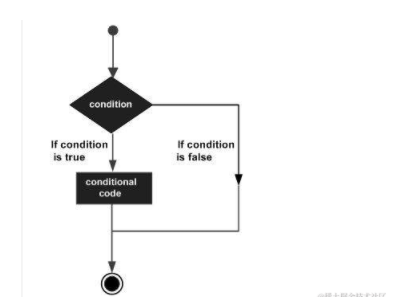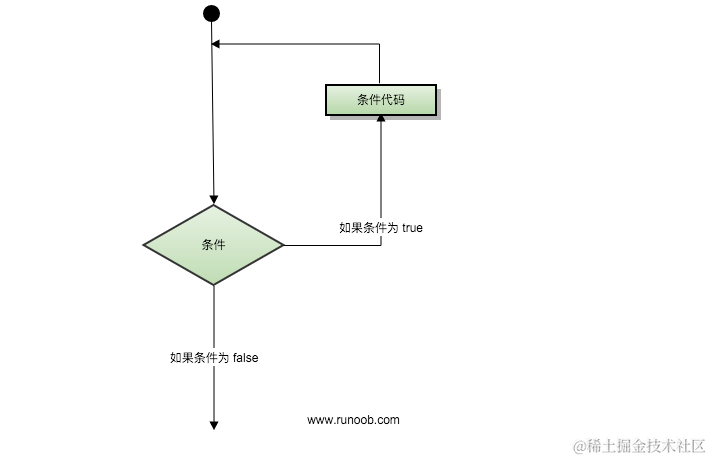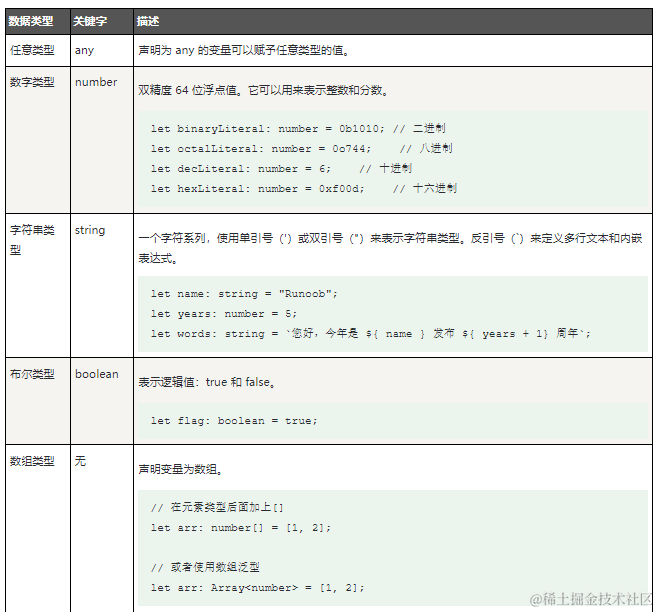1、TypeScript 類
TypeScript 是面向對象的 JavaScript。
類描述了所創建的對象共同的屬性和方法。
TypeScript 支持面向對象的所有特性,比如 類、接口等。
TypeScript 類定義方式如下:
class class_name {
// 類作用域
}
定義類的關鍵字為 class,后面緊跟類名,類可以包含以下幾個模塊(類的數據成員):
- 字段 ? 字段是類里面聲明的變量。字段表示對象的有關數據。
- 構造函數 ? 類實例化時調用,可以為類的對象分配內存。
- 方法 ? 方法為對象要執行的操作。
實例
鴻蒙開發文檔參考:[qr23.cn/AKFP8k]
創建一個 Person 類:
TypeScript
class Person { }復制
編譯以上代碼,得到以下 JavaScript 代碼:
JavaScript
var Person = /** @class */ (function () {
function Person() {
}
return Person;
}());復制
2、創建類的數據成員

以下實例我們聲明了類 Car,包含字段為 engine,構造函數在類實例化后初始化字段 engine。
this 關鍵字表示當前類實例化的對象。注意構造函數的參數名與字段名相同,this.engine 表示類的字段。
此外我們也在類中定義了一個方法 disp()。
## TypeScript
class Car {
// 字段
engine:string;
// 構造函數
constructor(engine:string) {
this.engine = engine
}
// 方法
disp():void {
console.log("發動機為 : "+this.engine)
}
}復制
編譯以上代碼,得到以下 JavaScript 代碼:
## JavaScript
var Car = /** @class */ (function () {
// 構造函數
function Car(engine) {
this.engine = engine;
}
// 方法
Car.prototype.disp = function () {
console.log("發動機為 : " + this.engine);
};
return Car;
}());復制
---
## 3、創建實例化對象
我們使用 new 關鍵字來實例化類的對象,語法格式如下:
var object_name = new class_name([ arguments ])
類實例化時會調用構造函數,例如:
var obj = new Car("Engine 1")
類中的字段屬性和方法可以使用 . 號來訪問:
// 訪問屬性
obj.field_name
// 訪問方法
obj.function_name()
### 完整實例
以下實例創建來一個 Car 類,然后通過關鍵字 new 來創建一個對象并訪問屬性和方法:
## TypeScript
class Car {
// 字段
engine:string;
// 構造函數
constructor(engine:string) {
this.engine = engine
}
// 方法
disp():void {
console.log("函數中顯示發動機型號 : "+this.engine)
}
}
// 創建一個對象
var obj = new Car("XXSY1")
// 訪問字段
console.log("讀取發動機型號 : "+obj.engine)
// 訪問方法
obj.disp()復制
編譯以上代碼,得到以下 JavaScript 代碼:
## JavaScript
var Car = /** @class */ (function () {
// 構造函數
function Car(engine) {
this.engine = engine;
}
// 方法
Car.prototype.disp = function () {
console.log("函數中顯示發動機型號 : " + this.engine);
};
return Car;
}());
// 創建一個對象
var obj = new Car("XXSY1");
// 訪問字段
console.log("讀取發動機型號 : " + obj.engine);
// 訪問方法
obj.disp();復制
讀取發動機型號 : XXSY1
函數中顯示發動機型號 : XXSY1
---
## 4、類的繼承
TypeScript 支持繼承類,即我們可以在創建類的時候繼承一個已存在的類,這個已存在的類稱為父類,繼承它的類稱為子類。
類繼承使用關鍵字 extends,子類除了不能繼承父類的私有成員(方法和屬性)和構造函數,其他的都可以繼承。
TypeScript 一次只能繼承一個類,不支持繼承多個類,但 TypeScript 支持多重繼承(A 繼承 B,B 繼承 C)。
語法格式如下:
class child_class_name extends parent_class_name
### 實例
類的繼承:實例中創建了 Shape 類,Circle 類繼承了 Shape 類,Circle 類可以直接使用 Area 屬性:
## TypeScript
class Shape {
Area:number
constructor(a:number) {
this.Area = a
}
}
class Circle extends Shape {
disp():void {
console.log("圓的面積: "+this.Area)
}
}
var obj = new Circle(223);
obj.disp()復制
編譯以上代碼,得到以下 JavaScript 代碼:
## JavaScript
var __extends = (this && this.__extends) || (function () {
var extendStatics = function (d, b) {
extendStatics = Object.setPrototypeOf ||
({ proto: [] } instanceof Array && function (d, b) { d.proto = b; }) ||
function (d, b) { for (var p in b) if (b.hasOwnProperty(p)) d[p] = b[p]; };
return extendStatics(d, b);
};
return function (d, b) {
extendStatics(d, b);
function () { this.constructor = d; }
d.prototype = b === null ? Object.create(b) : (.prototype = b.prototype, new __());
};
})();
var Shape = /** @class / (function () {
function Shape(a) {
this.Area = a;
}
return Shape;
}());
var Circle = /* @class */ (function (_super) {
__extends(Circle, _super);
function Circle() {
return _super !== null && _super.apply(this, arguments) || this;
}
Circle.prototype.disp = function () {
console.log("圓的面積: " + this.Area);
};
return Circle;
}(Shape));
var obj = new Circle(223);
obj.disp();復制
輸出結果為:
圓的面積: 223
需要注意的是子類只能繼承一個父類,TypeScript 不支持繼承多個類,但支持多重繼承,如下實例:
## TypeScript
class Root {
str:string;
}
class Child extends Root {}
class Leaf extends Child {} // 多重繼承,繼承了 Child 和 Root 類
var obj = new Leaf();
obj.str ="hello"
console.log(obj.str)復制
編譯以上代碼,得到以下 JavaScript 代碼:
## JavaScript
var __extends = (this && this.__extends) || (function () {
var extendStatics = function (d, b) {
extendStatics = Object.setPrototypeOf ||
({ proto: [] } instanceof Array && function (d, b) { d.proto = b; }) ||
function (d, b) { for (var p in b) if (b.hasOwnProperty(p)) d[p] = b[p]; };
return extendStatics(d, b);
};
return function (d, b) {
extendStatics(d, b);
function () { this.constructor = d; }
d.prototype = b === null ? Object.create(b) : (.prototype = b.prototype, new __());
};
})();
var Root = /** @class / (function () {
function Root() {
}
return Root;
}());
var Child = /* @class / (function (_super) {
__extends(Child, _super);
function Child() {
return _super !== null && _super.apply(this, arguments) || this;
}
return Child;
}(Root));
var Leaf = /* @class */ (function (_super) {
__extends(Leaf, _super);
function Leaf() {
return _super !== null && _super.apply(this, arguments) || this;
}
return Leaf;
}(Child)); // 多重繼承,繼承了 Child 和 Root 類
var obj = new Leaf();
obj.str = "hello";
console.log(obj.str);復制
輸出結果為:
hello
---
## 5、繼承類的方法重寫
類繼承后,子類可以對父類的方法重新定義,這個過程稱之為方法的重寫。
其中 super 關鍵字是對父類的直接引用,該關鍵字可以引用父類的屬性和方法。
## TypeScript
class PrinterClass {
doPrint():void {
console.log("父類的 doPrint() 方法。")
}
}
class StringPrinter extends PrinterClass {
doPrint():void {
super.doPrint() // 調用父類的函數
console.log("子類的 doPrint()方法。")
}
}復制
編譯以上代碼,得到以下 JavaScript 代碼:
## JavaScript
var obj = new StringPrinter()
obj.doPrint()
var __extends = (this && this.__extends) || (function () {
var extendStatics = function (d, b) {
extendStatics = Object.setPrototypeOf ||
({ proto: [] } instanceof Array && function (d, b) { d.proto = b; }) ||
function (d, b) { for (var p in b) if (b.hasOwnProperty(p)) d[p] = b[p]; };
return extendStatics(d, b);
};
return function (d, b) {
extendStatics(d, b);
function () { this.constructor = d; }
d.prototype = b === null ? Object.create(b) : (.prototype = b.prototype, new __());
};
})();
var PrinterClass = /** @class / (function () {
function PrinterClass() {
}
PrinterClass.prototype.doPrint = function () {
console.log("父類的 doPrint() 方法。");
};
return PrinterClass;
}());
var StringPrinter = /* @class */ (function (_super) {
__extends(StringPrinter, _super);
function StringPrinter() {
return _super !== null && _super.apply(this, arguments) || this;
}
StringPrinter.prototype.doPrint = function () {
_super.prototype.doPrint.call(this); // 調用父類的函數
console.log("子類的 doPrint()方法。");
};
return StringPrinter;
}(PrinterClass));
var obj = new StringPrinter();
obj.doPrint();復制
輸出結果為:
父類的 doPrint() 方法。
子類的 doPrint()方法。
---
## 6、static 關鍵字
static 關鍵字用于定義類的數據成員(屬性和方法)為靜態的,靜態成員可以直接通過類名調用。
## TypeScript
class StaticMem {
static num:number;
static disp():void {
console.log("num 值為 "+ StaticMem.num)
}
}
StaticMem.num = 12 // 初始化靜態變量
StaticMem.disp() // 調用靜態方法復制
編譯以上代碼,得到以下 JavaScript 代碼:
## JavaScript
var StaticMem = /** @class */ (function () {
function StaticMem() {
}
StaticMem.disp = function () {
console.log("num 值為 " + StaticMem.num);
};
return StaticMem;
}());
StaticMem.num = 12; // 初始化靜態變量
StaticMem.disp(); // 調用靜態方法復制
輸出結果為:
num 值為 12
---
## 7、instanceof 運算符
instanceof 運算符用于判斷對象是否是指定的類型,如果是返回 true,否則返回 false。
## TypeScript
class Person{ }
var obj = new Person()
var isPerson = obj instanceof Person;
console.log("obj 對象是 Person 類實例化來的嗎? " + isPerson);復制
編譯以上代碼,得到以下 JavaScript 代碼:
## JavaScript
var Person = /** @class */ (function () {
function Person() {
}
return Person;
}());
var obj = new Person();
var isPerson = obj instanceof Person;
console.log(" obj 對象是 Person 類實例化來的嗎? " + isPerson);復制
輸出結果為:
obj 對象是 Person 類實例化來的嗎? true
---
## 8、訪問控制修飾符
TypeScript 中,可以使用訪問控制符來保護對類、變量、方法和構造方法的訪問。TypeScript 支持 3 種不同的訪問權限。
* **public(默認)** : 公有,可以在任何地方被訪問。
* **protected** : 受保護,可以被其自身以及其子類訪問。
* **private** : 私有,只能被其定義所在的類訪問。
以下實例定義了兩個變量 str1 和 str2,str1 為 public,str2 為 private,實例化后可以訪問 str1,如果要訪問 str2 則會編譯錯誤。
## TypeScript
class Encapsulate {
str1:string = "hello"
private str2:string = "world"
}
var obj = new Encapsulate()
console.log(obj.str1) // 可訪問
console.log(obj.str2) // 編譯錯誤, str2 是私有的復制
---
## 9、類和接口
類可以實現接口,使用關鍵字 implements,并將 interest 字段作為類的屬性使用。
以下實例中 AgriLoan 類實現了 ILoan 接口:
## TypeScript
interface ILoan {
interest:number
}
class AgriLoan implements ILoan {
interest:number
rebate:number
constructor(interest:number,rebate:number) {
this.interest = interest
this.rebate = rebate
}
}
var obj = new AgriLoan(10,1)
console.log("利潤為 : "+obj.interest+",抽成為 : "+obj.rebate )復制
編譯以上代碼,得到以下 JavaScript 代碼:
## JavaScript
ar AgriLoan = /** @class */ (function () {
function AgriLoan(interest, rebate) {
this.interest = interest;
this.rebate = rebate;
}
return AgriLoan;
}());
var obj = new AgriLoan(10, 1);
console.log("利潤為 : " + obj.interest + ",抽成為 : " + obj.rebate);復制
輸出結果為:
利潤為 : 10,抽成為 : 1
審核編輯 黃宇
-
javascript
+關注
關注
0文章
516瀏覽量
53795 -
鴻蒙
+關注
關注
57文章
2321瀏覽量
42749
發布評論請先 登錄
相關推薦
鴻蒙TypeScript入門學習第6天:【條件語句】

鴻蒙TypeScript學習第7天:【TypeScript 循環】

鴻蒙TypeScript 開發學習第9天:【TypeScript Number】

鴻蒙語言TypeScript學習第15天:【聯合類型】

鴻蒙TypeScript學習第20天:【模塊】

【觸覺智能 Purple Pi OH 開發板體驗】二、鴻蒙系統APP應用例程學習HDC使用學習
要成為鴻蒙開發者,應該學習哪些編程語言
鴻蒙TypeScript入門學習第8天:【TypeScript 函數】





 鴻蒙語言TypeScript學習第16天:【類】
鴻蒙語言TypeScript學習第16天:【類】













評論